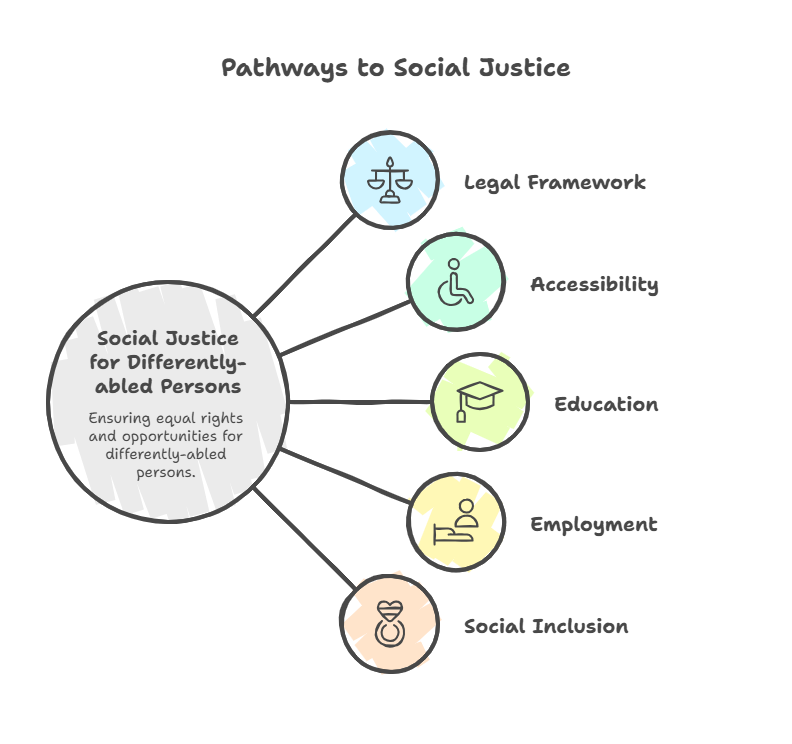- Filter By :
- Polity & Governance
- International Relations
- Social Justice
-
Q. How effective are the policies aimed at ensuring social justice for differently-abled persons in India? Discuss the gaps that still exist in the implementation of these policies. (250 words)
08 Jul, 2025 GS Paper 2 Social JusticeApproach:
- Introduce by highlighting a recent milestone upholding the rights of differently-abled persons in India
- Delve into Key Policies for Social Justice for Differently-abled Persons in India
- Highlight Effectiveness of the Policies
- Mention Gaps in the Implementation of Policies and suggest Measures for Improvement
- Conclude with a related convention.
Introduction:
In the recent Rajive Raturi vs. Union of India (2023) case, the Supreme Court reaffirmed that the right of differently-abled persons to access services and opportunities is a fundamental human right.
- However, despite legal advancements like the Rights of Persons with Disabilities (RPWD) Act, 2016, gaps remain in the implementation of these rights, with PwDs still facing barriers in accessibility, education, and employment.
Body:
Key Policies for Social Justice for Differently-abled Persons in India:
- The Rights of Persons with Disabilities (RPWD) Act, 2016: The RPWD Act expanded the definition of disability to 21 categories and guarantees the rights of PwDs across education, employment, healthcare, and accessibility.
- The Act mandates 4% job reservations in government jobs and 5% in higher education, aiming to integrate PwDs into mainstream society.
- Accessible India Campaign (Sugamya Bharat Abhiyan): Launched in 2015, this campaign focuses on improving the accessibility of public spaces, transportation systems, and digital infrastructure for PwDs.
- National Trust Act, 1999: This Act provides support for PwDs with autism, cerebral palsy, mental retardation, and multiple disabilities through various welfare measures.
- Mental Healthcare Act, 2017: It addresses the rights and care needs of persons with mental illness, aiming for inclusive mental healthcare services.
Effectiveness of the Policies:
- Positive Developments:
- The Supreme Court’s guidelines for media representation are helping to challenge stereotypes and promote a more inclusive and respectful society for PwDs.
- A notable example of this is the recent movie Sitare Zameen Par, which serves as a hallmark of such positive portrayals.
- Web Content Accessibility Guidelines (WCAG) 2.1 covers a wide range of recommendations for making web content more accessible.
- The broadcasting of IPL matches with sign language interpretation is a significant step in the right direction.
- The Supreme Court’s guidelines for media representation are helping to challenge stereotypes and promote a more inclusive and respectful society for PwDs.
- Areas of Limited Effectiveness Due to:
- Digital Exclusion: A study by the Digital Empowerment Foundation (DEF, 2024) found that only 36.61% of PwDs regularly use digital services, primarily due to inaccessible websites and lack of assistive technology.
- Employment Barriers: PwDs face significant challenges in finding employment due to workplace discrimination, inaccessible work environments, and limited vocational training.
- Despite the 4% reservation, only 34 lakh of the 1.3 crore employable PwDs are employed.
Gaps in the Implementation of Policies:
- Legal and Bureaucratic Hurdles: The implementation of policies often remains on paper due to bureaucratic inefficiencies.
- For instance, many states have not constituted State Advisory Boards on disability as mandated by the RPWD Act, 2016.
- PwDs often face challenges in obtaining a Unique Disability ID (UDID) due to complex procedures and lack of digital infrastructure, further hindering their access to benefits.
- Societal Stigma and Awareness: Despite legal frameworks, societal attitudes remain deeply rooted in ableism. PwDs continue to be viewed through the lens of charity rather than equality, leading to exclusion in social, educational, and employment settings.
- Media representation of PwDs is minimal and often stereotypical, reinforcing negative perceptions.
- Inaccessibility in Rural and Marginalized Communities: A significant portion of the PwD population lives in rural areas (around 69%), where accessibility remains a major issue.
- Gender, caste, and rural-urban divides exacerbate the challenges faced by PwDs, with women and marginalized groups facing multiple layers of discrimination.
- Infrastructure and Healthcare Gaps: Although the RPWD Act mandates accessible infrastructure, only 3% of India's buildings are fully accessible.
- Moreover, healthcare services are often not disability-friendly, and public health schemes like Ayushman Bharat do not adequately cover assistive devices or long-term disability care.
Measures to Enhance Effectiveness of the Policies:
- Strengthening Implementation and Monitoring: Establish robust mechanisms for monitoring and accountability to ensure full enforcement of the RPWD Act, 2016.
- Regular audits of government and private sector compliance with disability-inclusive measures are essential to address non-compliance.
- Inclusive Employment Practices: Implement a national-level disability-inclusive employment policy that mandates accessible work environments, reasonable accommodations, and flexibility in hiring processes.
- Provide incentives for companies to hire PwDs and track their employment progress.
- Comprehensive Healthcare Services: Integrate disability-specific needs into national healthcare schemes like Ayushman Bharat, covering assistive devices, long-term rehabilitation, and specialized mental health services.
- Simplifying Bureaucratic Processes: Streamline the process of obtaining a Unique Disability ID (UDID) and make welfare applications more accessible through mobile apps, ensuring PwDs can easily access benefits without bureaucratic delays.
- Increased Awareness and Sensitization: Launch nationwide awareness campaigns to change societal attitudes and promote the inclusion of PwDs.
- Schools, workplaces, and media should be engaged to foster a culture of respect and empathy for people with disabilities.
Conclusion:
"The only true disability is the inability to accept and respect differences." It is crucial that India moves beyond the compliance mindset and fosters a culture of full inclusion, ensuring that Divyangs can participate meaningfully in the nation’s progress, both in digital and physical spaces upholding the UN Convention on the Rights of Persons with Disabilities (CRPD).
To get PDF version, Please click on "Print PDF" button.
Print PDF





